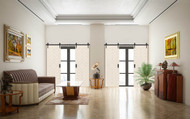A Guide to the Art Nouveau Design Style
Jan 6th 2021
Art nouveau design style originated in Paris and London and had the most influence in the late-19th and early-20th centuries. As opposed to the more restrained design movements in the mid-19th century, art nouveau encourages decorative elements, even in the most unexpected places.
The hallmarks of the art nouveau style include flowing lines and floral motifs that are inspired by nature. It is also characterized by an appreciation for hand-made and unique everyday items.
Houses from the art nouveau era were often built with the art nouveau aesthetic in mind. Built-in wood carvings, custom tiling, and unique architectural choices could all be a part of the design’s aesthetic. While it may be unrealistic to implement all of these design elements in houses built more recently, implementing the art nouveau aesthetic in key areas of a home can have satisfying results.
Are you interested in implementing this unique approach to interior design? Read on for some key ideas to keep in mind as you introduce art nouveau elements into your home.
Opt for Everyday Objects That Look Like Art
The art nouveau style embraces unique, one-of-a-kind objects that have as much decorative appeal as they do utility. Unlike other popular design movements such as industrialism and minimalism, art nouveau encourages elaborate flourishes and embellishments in these objects.
Why have plain wooden planks for bannisters when you could have pillars carved with floral designs? The closer you look at an art nouveau–inspired interior, the more elaborate details you will find. Wherever beauty can be added, it is.
Keep a Muted, Nature-Inspired Palette
Even though the art nouveau style encourages the use of patterns, it does not necessarily embrace a bright color scheme. In fact, traditional art nouveau interiors tend to rely on a nature-inspired palette of neutrals and pastels. Sticking to the color scheme allows you to mix designs and patterns while still keeping a room cohesive.
Mix Materials
The turn of the 20th century was a time of innovation for manufacturing, and the art nouveau movement reflects this in the variety of materials it used. Twisting metal doorknobs, botanical gardens carved into the back of chairs, and stained-glass lamps all fit into the art nouveau aesthetic.
In addition, art nouveau explores asymmetry to a greater extent than many other popular design movements. An asymmetrical vase or light fixture can add interest to a space and help with the natural feel the art nouveau aesthetic encourages. Pushing material to its limit allows more beauty to fit into every inch of space.
Decorate Areas That Most People Forget
Implement elements of the art nouveau style in places that often remain undecorated, particularly with furniture, decorations, and easily changed fixtures such as doors, knobs, wallpaper, and lighting. Draw attention to your favorite areas in a room with intricate patterns and your most unique and beloved pieces.
Examine more “plain” areas of your home and consider the impact that a more decorative piece could have. Changing the plain circle knobs on a dresser to knobs with a swirling floral motif could add the interest a room was lacking.
Perhaps the most important lesson to take from the art nouveau movement is to reconsider the beauty everyday objects can hold. Everything found in a home has the opportunity to be beautiful.
Customize Your Interior
While having an artisan create every piece in your home by hand may be unrealistic, a sharp eye for unique pieces can create a distinctive interior that guests will remember. Vintage furniture found at a thrift shop, an old lamp passed down for generations, or a highly customizable door all have the potential to add individuality to your space.
Make sure to carefully consider how each item in your interior can add more than utility to a room. For example, a door should not only open and close but actively makes your space more beautiful. Sliding barn doors add the perfect touch of unexpected whimsy to a room. The sliding motion to open them feels more natural and inviting than traditional doors.
The Marfa Barn Door from BarnDoorz may be the perfect accent door to finish off your art nouveau–inspired room. The simple design is understated yet reminds of the natural world with its a leaf-like pattern. It features a neutral toned finish that works well in an art nouveau color scheme. Customize everything from the handle design to the handle placement to the header board to make the door work with your unique interior.
Contact BarnDoorz today for help creating your art nouveau–inspired home interior.
